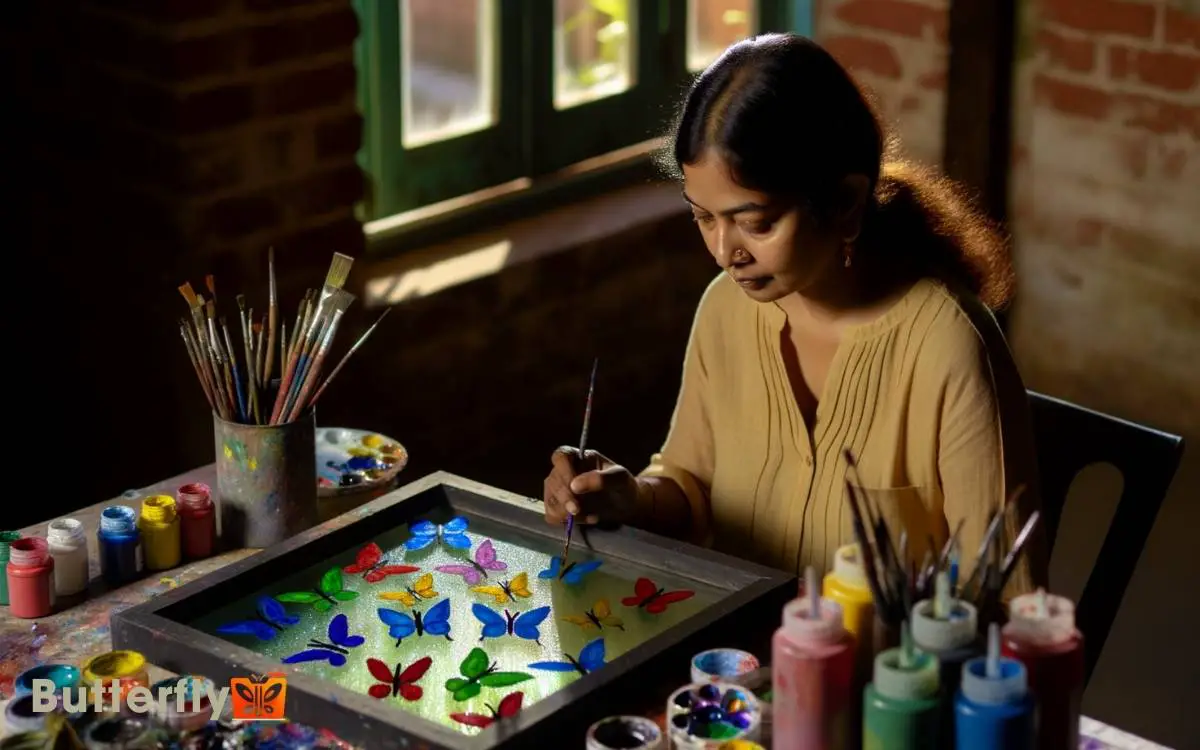Glass Painting Lady With Butterflies: Elegant Art Ideas!
The glass painting motif of a lady with butterflies captivates through its historical roots and deep symbolism.
Originating from a tradition that dates back to ancient civilizations, this theme marries the delicate whimsy of butterflies symbols of transformation and freedom with the refined elegance of classical female figures.
Artisans meticulously select materials, employing vibrant hues and fine brushes to capture intricate details. The choice of high-quality glass and skilled techniques guarantees both durability and aesthetic appeal.
This interplay of historical craftsmanship and thoughtful creativity invites viewers to explore its intricate details and profound meanings further.

Key Takeaways
History of Glass Painting
Glass painting, an art form that dates back to ancient Egypt and Rome, has evolved through various cultures and epochs to become a refined and cherished medium of artistic expression.
In its early days, artisans used glass panels to create vivid depictions of daily life, mythology, and religious iconography. Medieval Europe saw the technique flourish in stained glass windows, illuminating cathedrals with biblical narratives.
The Renaissance period introduced more sophisticated methods, enhancing color and detail. By the 19th century, glass painting became accessible to broader audiences, democratizing the art form.
Today, it remains a dynamic medium, blending traditional techniques with modern innovations, embodying a rich legacy that continues to captivate and inspire artists and admirers alike.
Inspiration Behind the Theme
Drawing upon a profound connection to nature and the ethereal beauty of butterflies, the artist channels these elements into her glass paintings, creating a vivid and intricate tableau that resonates with viewers on multiple levels.
Her inspiration draws from the delicate yet powerful symbolism of butterflies representing transformation, freedom, and the fleeting nature of life. Each piece aims to capture the delicate interplay between light and color, reflecting the transient beauty found in nature.
The artist’s choice of butterflies as a central motif is deliberate, inviting viewers to appreciate the nuanced and ephemeral qualities of life. This thematic focus not only enhances the visual appeal of her work but also imparts a deeper, contemplative message to her audience.
Materials and Tools Needed
To achieve the intricate details and vibrant hues in her glass paintings, the artist meticulously selects each material and tool, making sure they align with her vision and technique. She relies on high-quality glass paint to achieve rich, lasting colors.
Brushes of varying sizes allow her to create both broad strokes and fine lines, essential for capturing the delicate wings of butterflies. A glass cleaner is indispensable for preparing the canvas, while a palette offers a surface for blending and mixing colors.
Additionally, the artist uses a lead liner for defining contours, adding depth and dimension. By carefully evaluating each tool’s purpose and quality, she guarantees her artistic expression remains unhampered, and her creations resonate with intricate beauty and precision.
Choosing the Right Glass
Choosing the best type of glass is essential for guaranteeing both the aesthetic appeal and durability of the finished painting. Different glass types offer varying benefits that can influence the final outcome.
For instance, tempered glass provides enhanced durability, making it suitable for high-traffic areas.
On the other hand, stained glass adds a unique, colorful effect but requires a more delicate handling. Evaluating these options allows artists to align their choice with their creative vision and practical needs.
| Glass Type | Key Characteristics |
|---|---|
| Tempered Glass | High durability, impact-resistant |
| Stained Glass | Colorful, intricate, delicate |
| Frosted Glass | Diffused light, privacy-focused |
| Clear Float Glass | Versatile, smooth surface |
Each type has its nuances, making the selection process a critical step in achieving the desired artistic effect.
Preparing Your Glass Canvas
Before the artistic journey begins, thoroughly cleaning and inspecting the glass canvas guarantees a pristine surface for painting.
This essential step assures that no dust, oils, or residues will interfere with the paint’s adhesion or the clarity of the final artwork.
Artists should follow these steps:
- Clean with Mild Soap: Use a mild soap and water solution to wipe the glass, making sure all dirt and oils are removed.
- Rinse and Dry: Thoroughly rinse the glass to remove any soap residue and dry it with a lint-free cloth to prevent streaks.
- Inspect for Flaws: Examine the glass for any scratches, chips, or imperfections that might impact the painting process.
A well-prepared canvas sets the foundation for a successful glass painting project.
Sketching the Lady
Carefully outlining the lady’s figure on the glass requires a steady hand and a keen eye for detail.
The artist must guarantee each line is precise, capturing the essence of the subject without room for error. This phase is vital; one misplaced stroke can disrupt the balance and flow of the entire piece.
It’s critical to use a non-permanent marker initially to make adjustments effortlessly. Observing proportions and maintaining symmetry is paramount to a lifelike representation.
The artist’s skill in rendering facial expressions and body posture adds depth and character to the sketch.
Evaluating the work from different angles helps identify imperfections early, allowing for corrections before moving on to the next intricate steps of the painting process.
Adding Butterfly Designs
Integrating the butterfly designs into the composition requires a keen understanding of balance and visual harmony to enhance the overall aesthetic. The placement of butterflies should complement the central figure without overwhelming the viewer.
To achieve this, consider the following:
- Scale and Proportion: Guarantee butterflies vary in size to maintain naturalism and to guide the viewer’s eye across the painting.
- Symmetry and Asymmetry: Utilize both symmetrical and asymmetrical arrangements to create dynamic visual interest and prevent monotony.
- Interactivity: Position butterflies to interact with the lady, such as one perched on her hand, to establish a narrative connection.
Selecting Vibrant Colors
To further enrich the composition, the selection of vibrant colors plays a pivotal role in bringing the butterflies and the lady to life, enhancing the narrative and emotional impact of the painting. The artist meticulously blends warm hues and soft pastels, ensuring that each element harmonizes with the overall theme. The delicate details in the wings, especially the painted lady butterfly coloring, add depth and realism, making the scene feel almost tangible. This thoughtful use of color not only captures the viewer’s attention but also evokes a sense of wonder and admiration for nature’s beauty.
By choosing hues that contrast yet complement one another, the artist creates a dynamic interplay between the subjects and their environment.
The table below encapsulates the significance of color in this artwork:
| Element | Color Choice | Emotional Impact |
|---|---|---|
| Butterflies | Bright Oranges, Blues | Joy, Freedom |
| Lady’s Attire | Deep Reds, Purples | Elegance, Mystery |
| Background | Soft Greens, Yellows | Harmony, Tranquility |
Each color choice is deliberate, aimed at evoking specific emotions and drawing the viewer’s eye to essential details, thereby enriching the visual narrative.
Painting Techniques for Glass
Mastering the art of painting on glass requires a blend of precision, patience, and the right set of tools to achieve a stunning and long-lasting result.
Here’s a quick checklist:
- Surface Preparation: Clean glass meticulously.
- Paint Selection: Use acrylic enamels or glass paints.
- Layering Technique: Apply thin, even coats.
These techniques ensure a professional and enduring finish.
Finishing Touches
Once the painting layers have dried, adding the final details and protective coatings can greatly enhance the artwork’s durability and visual appeal.
Emphasizing intricate elements, such as the delicate patterns on butterfly wings or the lady’s flowing dress, can greatly elevate the piece’s overall aesthetic. Using fine-tipped brushes and steady hands guarantees precision in these finishing touches.
Applying a clear, UV-resistant varnish provides essential protection against fading and environmental damage. This step also adds a glossy finish, making colors appear more vibrant and lifelike.
By carefully evaluating each stroke and layer, the artist ensures that the final piece not only captivates viewers but also stands the test of time.
Therefore, mastering these finishing touches is important for any glass painting.
Preserving Your Artwork
Preserving your artwork involves not only the application of protective coatings but also understanding proper storage and display methods to guarantee its longevity.
Protecting glass paintings, especially intricate ones like ‘Lady With Butterflies,’ requires a multi-faceted approach.
- Protective Coatings: Apply a UV-resistant varnish specifically designed for glass to shield the painting from harmful light exposure that can cause fading.
- Climate Control: Store the artwork in a stable environment with controlled temperature and humidity levels to prevent warping or condensation buildup.
- Handling and Storage: Use acid-free materials and padded storage solutions to avoid scratches or other physical damage.
These steps safeguard that the vibrant beauty of the painting is preserved for years to come, maintaining its artistic and monetary value.
Displaying Your Masterpiece
When displaying a glass painting like ‘Lady With Butterflies,’ the choice of location greatly impacts its visual appeal and preservation.
Proper lighting enhances the vibrant colors and intricate details, while thoughtful framing protects and accentuates the artwork.
Assessing these factors guarantees the masterpiece captivates viewers while maintaining its integrity.
Choosing Display Locations
Selecting the ideal location to display your glass painting of a lady with butterflies is crucial for maximizing its visual impact and preserving its intricate details. Consideration of the environment guarantees the artwork is both appreciated and protected.
When choosing a display spot, focus on the following key factors:
- Traffic Flow: Position the painting where it won’t be easily knocked or brushed against. High-traffic areas can lead to accidental damage.
- Height: Place the painting at eye level to make it easily viewable. This height also reduces the risk of it being touched or bumped.
- Wall Color: Ensure the background color complements the painting. A contrasting wall can enhance the artwork’s vibrancy, ensuring it stands out and captivates viewers.
Lighting and Framing Tips
While selecting the perfect location is crucial, optimizing the lighting and framing of the glass painting of a lady with butterflies enhances its visual appeal and guarantees its longevity.
Proper lighting accentuates the vibrant colors and intricate details, while the right frame provides structural support and aesthetic harmony.
Consider these factors:
| Factor | Recommendation | Benefit |
|---|---|---|
| Lighting Type | Soft LED lights | Minimizes glare and UV damage |
| Light Source | Adjustable spotlights | Focuses on key elements |
| Frame Material | UV-protective glass and wood | Prevents fading and warping |
| Frame Style | Minimalistic or ornate | Complements painting’s theme |
| Positioning | Eye-level and angled slightly | Enhances visibility and impact |
These tips ensure the masterpiece remains a captivating focal point.
Conclusion
To sum up, the art of glass painting demands both skill and passion, particularly when crafting a piece as detailed as a lady with butterflies.
By delving into its history and mastering the techniques, one can elevate a plain glass canvas into a breathtaking masterpiece.
As the adage goes, ‘Practice makes perfect,’ so feel free to experiment and refine your craft. With proper care and thoughtful display, your artwork will captivate viewers for years to come.







Your point of view caught my eye and was very interesting. Thanks. I have a question for you.
Thank you for your sharing. I am worried that I lack creative ideas. It is your article that makes me full of hope. Thank you. But, I have a question, can you help me?
Thanks for sharing. I read many of your blog posts, cool, your blog is very good.
Thanks for sharing. I read many of your blog posts, cool, your blog is very good.
Your point of view caught my eye and was very interesting. Thanks. I have a question for you.
Thanks for sharing. I read many of your blog posts, cool, your blog is very good.
Can you be more specific about the content of your article? After reading it, I still have some doubts. Hope you can help me.